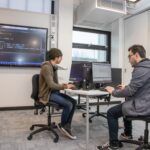In today’s rapidly evolving job market, continuous learning has become crucial for professionals to stay relevant and competitive. As industries undergo rapid transformations, upskilling and reskilling have become essential for employees to adapt and thrive. One powerful tool that is revolutionizing the learning landscape is classroom technology. By harnessing the potential of technology in the classroom, organizations can provide their employees with effective and efficient opportunities for upskilling and reskilling.
1. Enhancing Learning Experience
Integrating technology tools in the classroom has the potential to transform traditional learning experiences into dynamic and interactive ones. The use of interactive whiteboards and digital projectors, for example, enables educators to present information in engaging ways, fostering active participation and enhancing comprehension. Additionally, online learning platforms and learning management systems offer employees the flexibility to access learning materials and resources anytime and anywhere, enabling personalized learning experiences that cater to individual needs and preferences. The integration of virtual reality (VR) and augmented reality (AR) simulations takes learning to a whole new level, allowing employees to practice skills in realistic scenarios, thus bridging the gap between theory and practical application.
The benefits of technology-enhanced learning are substantial. By promoting increased engagement and active participation, classroom technology captivates learners’ attention and promotes a deeper understanding of the subject matter. Moreover, the personalized learning experiences made possible through technology ensure that employees receive targeted instruction tailored to their specific needs, maximizing their learning potential. Additionally, the accessibility of a wide range of learning resources, including videos, interactive modules, and e-books, empowers employees to explore different avenues of knowledge and stay up to date with the latest industry trends. Real-world success stories of individuals who have leveraged classroom technology to upskill or reskill are testament to its effectiveness in enhancing learning outcomes and professional growth.
2. Flexibility and Accessibility
The advent of online and remote learning opportunities has revolutionized the way employees can upskill and reskill. Asynchronous learning, facilitated through recorded lectures and materials, allows employees to learn at their own pace, fitting their educational pursuits around their work commitments. Synchronous learning, on the other hand, enables employees to participate in live sessions via video conferencing and collaboration tools, fostering real-time interactions and fostering a sense of community among learners, regardless of their geographical locations.
The flexibility and accessibility provided by technology in the classroom remove barriers that previously hindered professional development. Geographical constraints are no longer an issue, as employees can access high-quality educational resources and connect with instructors and peers from around the globe. Furthermore, technology-driven learning can accommodate different learning styles and preferences, ensuring that employees receive education in a format that suits them best. By allowing employees to balance their work responsibilities with their learning commitments, classroom technology encourages a culture of continuous learning within organizations, leading to empowered and motivated employees.
3. Data-Driven Insights and Personalized Learning
One of the greatest advantages of classroom technology is the wealth of data it generates, which can be leveraged to drive continuous improvement. Learning analytics enables instructors to track learners’ progress and identify areas for improvement, ensuring that the learning experience is tailored to address individual needs. By analyzing data, organizations can identify skill gaps and develop targeted interventions to bridge them effectively. This data-driven approach facilitates a more efficient and personalized learning journey for employees, allowing them to focus on areas that require the most attention.
Furthermore, adaptive learning technologies and intelligent tutoring systems leverage data to deliver personalized learning experiences. These systems assess learners’ knowledge and understanding and adapt content accordingly, ensuring that each individual is appropriately challenged. Through personalized recommendations and feedback, employees receive guidance that is tailored to their specific strengths and weaknesses, enhancing their learning outcomes and maximizing their potential for professional growth.
Takeaway
The role of classroom technology in upskilling and reskilling employees cannot be overstated. It enhances the learning experience, offers flexibility and accessibility, and enables data-driven insights and personalized learning journeys. Organizations and individuals alike should embrace technology as an integral part of their continuous learning and professional development strategies.
To stay ahead in today’s competitive job market, professionals must prioritize upskilling and reskilling. Classroom technology provides the means to navigate these learning journeys effectively, enabling individuals to remain agile and adaptable in the face of changing industry demands. Embracing technology is not just an option but a necessity for organizations and individuals committed to fostering a culture of continuous learning and professional growth.
So, let us embrace the power of classroom technology, leverage its capabilities, and embark on a journey of lifelong learning. By doing so, we can ensure that we remain valuable contributors to our organizations, seize new opportunities, and stay ahead of the curve in our careers. The possibilities are endless when we combine our ambition and dedication with the remarkable tools at our disposal.
Let classroom technology be our ally in upskilling and reskilling, guiding us towards a future brimming with professional success and personal fulfillment.









